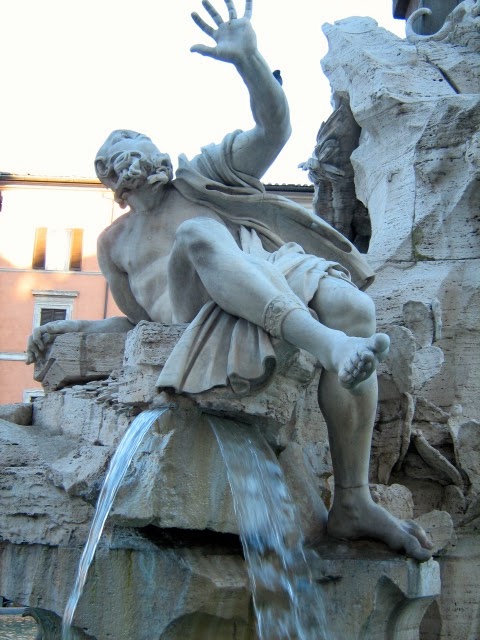"Leap, and the net will appear." I'm hoping this is true, for I have taken an almighty leap by relocating to Rome from Canada. Italy has long exerted an enormous pull, so let's see what this gigantic leap will bring!
Monday 27 January 2014
What lies beneath Piazza Navona
How many times have we all criss-crossed Piazza Navona, one of the most popular spots for visitors to Rome, without thinking about the layers of history that lie beneath its beautiful fountains, its cobblestones and concrete benches, buskers and vendors?
Well, it has now become easier to get a glimpse of its long history, as a small section of the original structure built there - the Stadium of Domiziano - has been opened to the public.
I visited it on Sunday with my friend and classics scholar Laura, who explained in great detail the origins of the site which was completed in about the year 86 by the mad emperor Domiziano for a great athletic event in honour of the god Jove.
(The photos below are from Bernini's great Fountain of the Four Rivers in the centre of today's Piazza Navona)
Laura explained that there are some misconceptions about the origins of the stadium that shaped today's Piazza Navona, including the fact it was, indeed, a stadium for athletic events and not a circus, like Circus Maximus, which was used for larger events such horse and chariot races. It was also interesting to learn that a stadium was originally a unit of measure that varied depending on where it was used. In Latin it often referred to 176 meters, the length of a particular foot race.
The Stadio di Domiziano was the first permanent athletic structure in Rome - previously, temporary venues were built, perhaps from wood - and this stadium was modelled on the style used in Greece. Looking at a modern reconstruction, it stuck me how similar it is to many sports stadiums I have seen in North America!
The stadium originally seated about 30,000 spectators and the shape of Piazza Navona almost exactly follows the sweep of the original oval structure, which included a beautiful marble viewing box for the emperor and other nobility on the spot where today's church of Sant'Agnese in Agone rests.
In fact, there is a connection here with the young Saint Agnes. Apparently, brothels had originally been established in certain arcades of this stadium structure, and it was in one of these where Agnes's martyrdom began, because she refused to marry as ordered by a later emperor, Diocletian. (Another small fact, the word "fornicate" is derived from the Latin name of the arch of an arcade, "fornix," according to Laura).
Still another fun fact, the word "Navona" as used in Piazza Navona, is derived from the term "agonalis" a combined Latin-Greek word for "struggles" describing the athletic competition in the original stadium….and over the years, was mispronounced until it became "Navona" (which, frankly, sounds better to me!)
Sunday 19 January 2014
A January Sunday in Rome.
As a girl from the Canadian Prairies, I am still gobsmacked by the sight of Rome in January, and just how very green everything is….even a few wild flowers are pushing their way through the hard soil of the Roman Forum.
How I love the sight of lemon tress and their bright fruit!
It was a bit cloudy as I made my way up the Capitoline Hill …
I felt sad to see that the gardeners of Rome's capitol hill have not been taking care of the delightful topiary figures of the iconic she-wolf, feeding babies Remus and Romulus (who now look like shaggy little shrubs)
Of course, I can never resist this shot of the Palatine Hill, from across Circus Maximus.
Friday 3 January 2014
Return to Rome's Monti neighbourhood
I'm happy to report that I am once again living in Rome's Monti area, where I lived for almost all of 2012. It's a great neighbourhood, snugged in beside the Imperial Forum which runs alongside the Roman Forum, divided only by the major Via dei Fori Imperial.
In fact, the western edge of Monti, known in ancient times as Subura, is formed by a high stone wall along Via Tor de’ Conti, which follows the contours of the forums of Augustus, Vespasian, Trajan, and Nerva.
The wall was built to protect Imperial Rome from the ancient slum, where Julius Caesar is said to have grown up.
Indeed, Monti remained a rather rough, unpopular neighbourhood until Rome became the capital of a united Italy in 1871.
I moved back in to Monti just in time to see the Christmas tree still set up in front of the Colosseum, now undergoing some restoration work and partly hidden under scaffolding.
The holiday tree will likely be removed right after the January 6 Epiphany holiday.
After hearing of the terrible snowstorms that people in Canada and parts of the United States have been facing in these first few days of January 2014, I am doubly thrilled to see lots of green grass around here.
Subscribe to:
Posts (Atom)
























